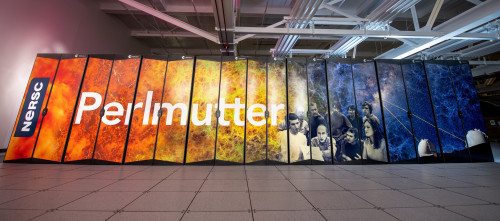QIS Project Shows Novel Method for Privacy-Preserving Quantum ML
April 20, 2023
By Keri Troutman
Contact: cscomms@lbl.gov
Quantum computing holds the promise of greatly advancing computational capabilities, and programs like the QIS@Perlmutter project at Lawrence Berkeley National Laboratory (Berkeley Lab) are bringing scientists together to conduct the foundational research that will support a quantum future.
QIS@Perlmutter, established in 2021 to support quantum information science (QIS) research conducted on the Perlmutter supercomputer at the National Energy Research Scientific Computing Center (NERSC), initially granted Perlmutter computing resources to 16 research teams in early 2022. Early scientific results from these projects are starting to emerge; in one recently published paper, “Quantum machine learning with differential privacy” (Nature Scientific Reports), a QIS@Perlmutter research group shared results of a quantum machine learning (QML) project that explores novel methods for preserving privacy within advanced quantum computing functions.

QML brings machine learning success to quantum computers with potential quantum advantages, including faster computation, convergence, and better accuracy with fewer complexities. Differential privacy provides the probabilistic privacy guarantee on a trained machine learning model, so an attacker cannot easily reveal private information from the training data. The goal is to protect training data from the training model.
This study marks the first proof-of-principle demonstration of privacy-preserving QML, which could ensure confidentiality and accurate learning on noisy intermediate-scale quantum (NISQ) technology, the researchers noted. In the current NISQ era, quantum computers with 50-100 qubits can perform tasks that surpass the capabilities of conventional computers, but “noise” surrounding the qubits limits the size of scientific problems that can be reliably executed.
From HEP to QML…
The path to this QML research began with a high energy physics (HEP) project led by Shinjae Yoo, a computational scientist and Machine Learning Group Lead at Brookhaven National Laboratory. Under that project, Yoo was able to engage a student through the Department of Energy’s Science Undergraduate Laboratory Internships (SULI) program to expand machine learning techniques gleaned from HEP analysis to advance quantum computing.
“Our hope is that quantum machine learning will outperform classical machine learning in classification power by exploiting a large number of qubits,” said Yoo. His QIS@Perlmutter research team’s project exploring how to build QML models that preserve privacy was partially built on the basic techniques created for HEP analysis.
Given that many datasets used in machine learning are crowd sourced or contain some private information, Yoo and his team wanted to demonstrate that differentially private QML can protect user-sensitive information without significantly diminishing model accuracy. They developed a hybrid quantum-classical model trained to preserve privacy using a differentially private optimization algorithm. These algorithms are known for curtailing information leakage from training data with improved model accuracy and faster convergence.
Yoo and his research team made use of NVIDIA cuQuantum, a software development kit of optimized libraries and tools designed to accelerate quantum computing simulations and workflows. “Quantum simulation made the most sense for this work,” said Yoo. “Simulating quantum circuits can be expensive and slow, but running quantum simulation with NVIDIA cuQuantum on the powerful Perlmutter computer enabled us to do much more, faster than we would have been able to otherwise.”
…And Back to HEP
In an interesting “feedback loop,” Yoo now hopes to apply his team’s QML techniques to other QIS@Perlmutter research projects, refocused on providing more powerful tools for data analysis in high energy physics. The discovery of new physics requires the identification of rare signals in immense backgrounds, and machine learning is well suited for this, he noted.
Still, analyzing the ever-larger volumes of data will require increasing computing resources in the next two decades. In the face of such big high-dimensional datasets, QML and computing resources like Perlmutter promise to help researchers yield big rewards. They are only now starting to test whether QML lives up to this promise.
“We got a bigger allocation on Perlmutter this year,” said Yoo. “That should really help us move this research forward.”
NERSC is a DOE Office of Science user facility.
About NERSC and Berkeley Lab
The National Energy Research Scientific Computing Center (NERSC) is a U.S. Department of Energy Office of Science User Facility that serves as the primary high performance computing center for scientific research sponsored by the Office of Science. Located at Lawrence Berkeley National Laboratory, NERSC serves almost 10,000 scientists at national laboratories and universities researching a wide range of problems in climate, fusion energy, materials science, physics, chemistry, computational biology, and other disciplines. Berkeley Lab is a DOE national laboratory located in Berkeley, California. It conducts unclassified scientific research and is managed by the University of California for the U.S. Department of Energy. »Learn more about computing sciences at Berkeley Lab.







